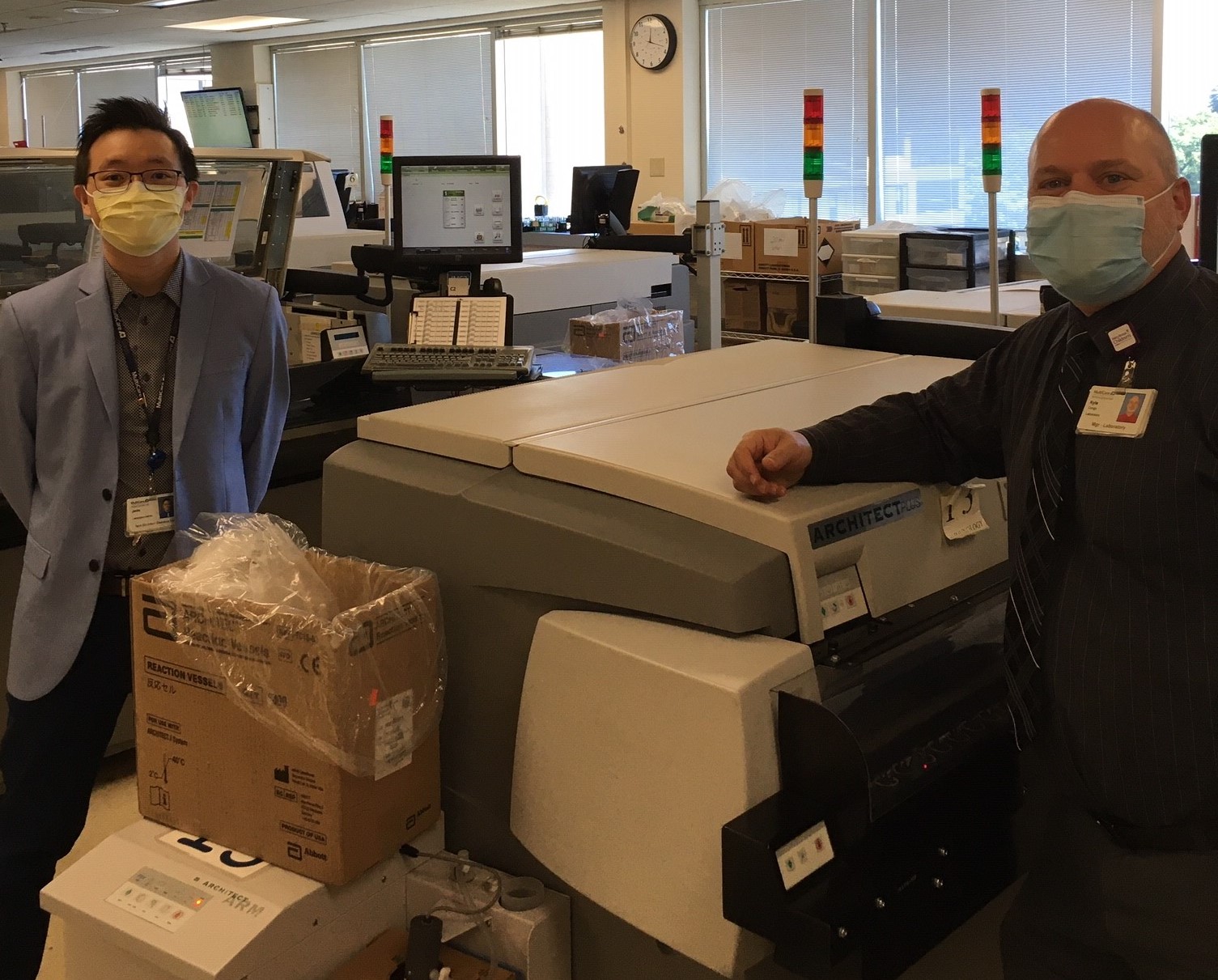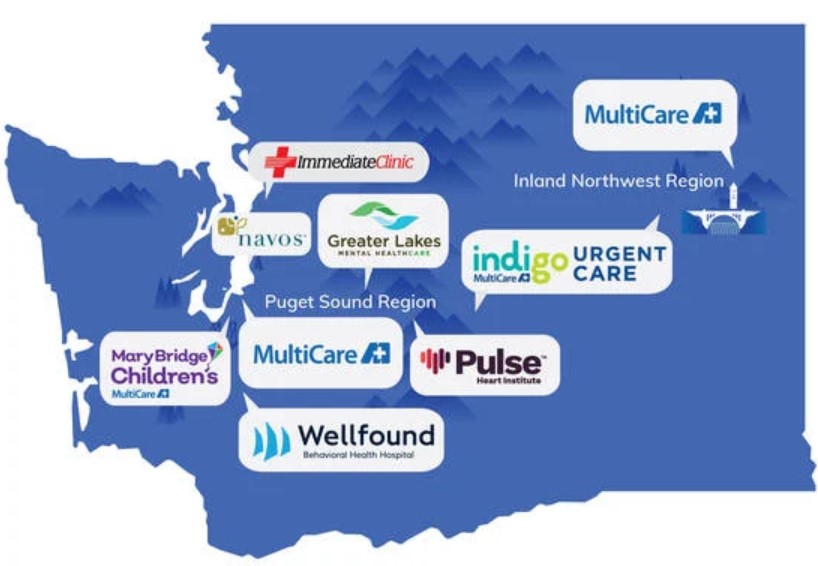Interviews
Multicare Health System: The COVID19 pandemic through the eyes of an 8-lab system
Kyle Congo and his colleagues share their experiences with COVID-19 testing in the Pacific Northwest
COVID-19 Pandemic response through the eyes of an eight-laboratory system.
Kyle Congo Dr. Jackie Chow, Multicare Health System
August 2020

Pictured with social distancing and masks, Dr. Chow (left) and Kyle Congo (right)

MultiCare is a not-for-profit health care organization with more than 18,000 team members, including employees, providers and volunteers. MultiCare is the largest community-based, locally governed health system in the state of Washington, with roots going back for well over a century, since the founding of Tacoma’s first hospital.
Their network of care includes eight hospitals:
•MultiCare Allenmore Hospital, Tacoma
•MultiCare Auburn Medical Center, Auburn
•MultiCare Covington Medical Center, Covington
•MultiCare Deaconess Hospital, Spokane
•MultiCare Good Samaritan Hospital, Puyallup
•Mary Bridge Children’s Hospital, Tacoma — the region’s only children’s hospital and state-designated Level II Pediatric Trauma Center for Western Washington
•MultiCare Tacoma General Hospital, Tacoma, which is home to the Puget Sound Region’s only Level IV Neonatal Intensive Care Unit
•MultiCare Valley Hospital, Spokane Valley
About the authors
Kyle Congo is the Core Laboratory Manager and he oversees Chemistry, Hematology, Coagulation and Urinalysis departments for the MultiCare Health System. Kyle has been in the Laboratory field for 25+ years. He is ASCP-MT certified and he obtained his Bachelors of Science in Biochemistry from the University of Calgary.
Dr. Chow is the Technical Director of Infectious Diseases Diagnostics at MultiCare Health System. He obtained his PhD in Microbiology and Immunology at the Albert Einstein College of Medicine, followed by his clinical fellowship at the University of Washington. He is board certified by the American Board of Medical Microbiology.
The MultiCare story
When this pandemic first began and we started seeing symptomatic patients in our hospitals the system stood up our Emergency Management Incident Command center at each facility and a System Incident Command Center (SICC). We quickly reached out to our partner reference laboratory in Seattle the week of March 2-6. They are a University laboratory that was developing a COVID-19 Laboratory Developed Test (LDT) that had an Emergency Use Approval (EUA) and were going to begin testing soon. We began sending our specimens to them for testing along with the State laboratory. The State laboratory began with a TAT of 3-5 days but once volumes increased during the first week, we quickly started to see an increase in Turn Around Times (TAT) so we began sending more samples to our Reference Laboratory and the TAT was around 2-3 days. The laboratory leadership team began a standing daily 1.5-hour meeting to discuss system options for reference laboratory testing, monitoring how to bring testing into the laboratory, and monitoring supplies (transport media/NP swabs).
See even more stories about COVID-19 Laboratory Challenges...
We quickly realized we would need to bring the COVID-19 PCR testing in house very quickly to help with the increasing test volume. The Microbiology department began looking at different platforms that were working on obtaining their EUA for the COVID-19 testing. We focused on platforms we were already using in the laboratory such as Diasorin, Cepheid, and GenMark ePlex. Diasorin and GenMark were among the fastest to bring the COVID-19 testing to market. In-house testing for COVID-19 PCR went live on March 27th. (When we were looking at these platforms, there were no high throughput instruments that were submitting the EUA for the COVID-19 PCR testing.)
We had enough reagents from the three vendors to be able to support our in-house emergent testing through April into mid-May. Then we began experiencing problems with vendor reagent allocation for certain platforms. (Cepheid) We started seeing missed shipments of reagents and decreased allocation. We had to modify the number of tests we were able to run within the laboratory and send more testing to our reference laboratory. As the EUA’s changed to include different acceptable transport media and collection criteria, we sent multiple communications to our physicians about acceptable specimens and criteria used to determine which specimens were run in the laboratory and which specimens were sent to our reference laboratory.
One of the biggest challenges during this time was the conservation of NP swabs and viral transport media because there was a National shortage for both. We switched from NP swabs to throat/nasal swabs that could only go to our reference laboratory as they validated and updated the EUA. We could only use the NP swabs for testing in our laboratory and with the national shortage we wanted to conserve the NP swabs and M6 transport media for other respiratory testing during this pandemic. We also began making our own saline tubes to be used instead of the viral transport media as the vendors began expanding the EUA’s for the COVID-19 PCR testing on their platforms to include saline as an acceptable transport media.
From Mid-May to present we have been trying to continue to conserve our Viral Transport Media as we have no confirmation that we will be receiving any more Viral Transport Media this year and we need it for other Molecular and Respiratory testing. At the end of May the hospitals in our system began performing surgical cases again. This increased the request for COVID-19 PCR testing. We brought our pre-surgical patient testing into the laboratory as our reagent volumes could handle.
Toward the end of June, we had to switch this testing to our reference laboratory as we were in jeopardy of running out of reagent for our emergent patient testing. The laboratory leadership team is currently meeting twice a week and we have expanded testing to three more laboratories and are waiting on instrumentation to be delivered to two more laboratories. Again, the challenge is reagent allocation from the vendor(s).We are on a waiting list to purchase two high through-put instruments. One for the hospitals in the Tacoma area and another for the hospitals in the Spokane area.
We did evaluate Point of Care Testing (POCT) early on but the history of the vendor was not very good in this arena and we decided it was not a good platform to move forward with testing. Currently we are revisiting the POCT for Covid-19 PCR and placing them at our free-standing Emergency Departments, Urgent Care Clinics, and select high through-put clinics.
COVID-19 IgG Antibody Serology
We began running COVID-19 IgG Antibody testing before the end of April. When we were approached by or current chemistry vendor, they indicated this was going to be a large volume test that if we did not sign up to run the test it would be very difficult to get reagent after the EUA was approved. We decided to validate it at all our laboratories the ran this platform. We found positive COVID-19 PCR patient samples from patients that were draws 11-15 days after the first positive result. We ran the COVID-19 IgG test and correlated to the clinical history. 21/22 were positive for the COVID-19 IgG antibody. The obtain known negative specimens we found specimens that were drawn in early 2019 that were kept frozen. We were concerned about the false positive rumors, so we ran 101 of the specimens and 101/101 were negative. We performed this validation at all our laboratories in our system that were running this platform. When the EUA was released we were running 80-90 specimens per day and within two weeks the volumes dropped to less than 40 per day. We decided to only run the test at on of our laboratories in Spokane and at our Core laboratory in Tacoma. The serology testing is qualitative and is not being used for diagnosis.
Today (July-August 2020)
We still find challenges with supplies and we are looking forward to obtaining a high throughput instrument. The volumes for the COVID-19 PCR testing have been increasing over the past few weeks that we are now faced with staffing issues to process the specimens to be sent to our reference laboratory. Our positivity rate in the beginning was around 10-15% but has slowly dropped. This is likely due to testing only symptomatic patients and now we are testing more asymptomatic patients. The positivity rate now is about 5%.
We are working very closely with our reference laboratory in Seattle. They have been great partners from the first peak of the pandemic through today.
